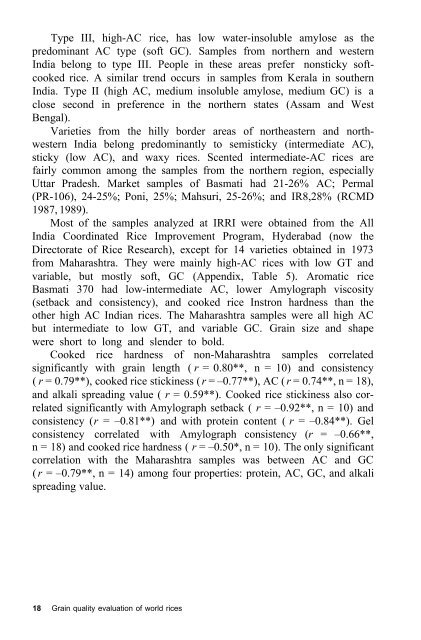Juliano et al. - 1993 - Grain Quality Evaluation of World Rices
Juliano et al. - 1993 - Grain Quality Evaluation of World Rices
Juliano et al. - 1993 - Grain Quality Evaluation of World Rices
You also want an ePaper? Increase the reach of your titles
YUMPU automatically turns print PDFs into web optimized ePapers that Google loves.
Type III, high-AC rice, has low water-insoluble amylose as the<br />
predominant AC type (s<strong>of</strong>t GC). Samples from northern and western<br />
India belong to type III. People in these areas prefer nonsticky s<strong>of</strong>tcooked<br />
rice. A similar trend occurs in samples from Ker<strong>al</strong>a in southern<br />
India. Type II (high AC, medium insoluble amylose, medium GC) is a<br />
close second in preference in the northern states (Assam and West<br />
Beng<strong>al</strong>).<br />
Vari<strong>et</strong>ies from the hilly border areas <strong>of</strong> northeastern and northwestern<br />
India belong predominantly to semisticky (intermediate AC),<br />
sticky (low AC), and waxy rices. Scented intermediate-AC rices are<br />
fairly common among the samples from the northern region, especi<strong>al</strong>ly<br />
Uttar Pradesh. Mark<strong>et</strong> samples <strong>of</strong> Basmati had 21-26% AC; Perm<strong>al</strong><br />
(PR-106), 24-25%; Poni, 25%; Mahsuri, 25-26%; and IR8,28% (RCMD<br />
1987, 1989).<br />
Most <strong>of</strong> the samples an<strong>al</strong>yzed at IRRI were obtained from the All<br />
India Coordinated Rice Improvement Program, Hyderabad (now the<br />
Directorate <strong>of</strong> Rice Research), except for 14 vari<strong>et</strong>ies obtained in 1973<br />
from Maharashtra. They were mainly high-AC rices with low GT and<br />
variable, but mostly s<strong>of</strong>t, GC (Appendix, Table 5). Aromatic rice<br />
Basmati 370 had low-intermediate AC, lower Amylograph viscosity<br />
(s<strong>et</strong>back and consistency), and cooked rice Instron hardness than the<br />
other high AC Indian rices. The Maharashtra samples were <strong>al</strong>l high AC<br />
but intermediate to low GT, and variable GC. <strong>Grain</strong> size and shape<br />
were short to long and slender to bold.<br />
Cooked rice hardness <strong>of</strong> non-Maharashtra samples correlated<br />
significantly with grain length ( r = 0.80**, n = 10) and consistency<br />
( r = 0.79**), cooked rice stickiness ( r = –0.77**), AC ( r = 0.74**, n = 18),<br />
and <strong>al</strong>k<strong>al</strong>i spreading v<strong>al</strong>ue ( r = 0.59**). Cooked rice stickiness <strong>al</strong>so correlated<br />
significantly with Amylograph s<strong>et</strong>back ( r = –0.92**, n = 10) and<br />
consistency ( r = –0.81**) and with protein content ( r = –0.84**). Gel<br />
consistency correlated with Amylograph consistency ( r = –0.66**,<br />
n = 18) and cooked rice hardness ( r = –0.50*, n = 10). The only significant<br />
correlation with the Maharashtra samples was b<strong>et</strong>ween AC and GC<br />
( r = –0.79**, n = 14) among four properties: protein, AC, GC, and <strong>al</strong>k<strong>al</strong>i<br />
spreading v<strong>al</strong>ue.<br />
18 <strong>Grain</strong> qu<strong>al</strong>ity ev<strong>al</strong>uation <strong>of</strong> world rices

















